Did you see Trump’s Tweet today: Consumption of Information on Twitter and birth of TweetCheck
With the constant evolution of new media, people are offered with more options on how to inform themselves on the current situation in the world. As Arkaitz Zubiaga et al. note, ‘while social media have become mainstream, as shown by the ever growing number of users, Twitter stands out as the quintessential platform to openly access real-time updates on breaking news and ongoing events’ (462).
However, as much as this platform provides an access to breaking news, it also raises questions about the quality and credibility of the 280-character ‘news’. Ott points out that ‘since tweeting requires little effort, it requires little forethought, reflection, or consideration of consequences’ (61). Thus, tweets discussing historic events can ultimately come across as hollow echoes even when they are posted by important political figures.
Furthermore, compared to the traditional media such as newspapers or radio, the consumption of news on Twitter is rather scattered as people follow different accounts, with 6,000 tweets on average being posted every second, reaching around 200 billion tweets per year (Internet Live Stats).
TweetCheck, a space for critical assessment of news contents
Our aim is to create a website, titled ‘TweetCheck‘, that would engage journalists, academics, students and the wider public as a place offering a full analysis of specific events through extracting information from multiple accounts on Twitter. Although there are websites which analyze individual Twitter accounts and their posts (i.e. Factbase, which provides a thorough analysis of Donald Trump’s account; CNN’s edition covering Trump’s activity on Twitter), they do not compare such accounts with others that mention the same event through hashtags or keywords. With ‘67% of Americans reporting that they get at least some of their news on social media’ (Shearer and Gottfried, 2017), we opt to build a tool which provides a space that unifies all the relevant news and its topics across Twitter in one page.
An accurate example will be demonstrated through a case study which provides academic analysis of an event depicted across multiple Twitter accounts within a certain time period. This would result in a visualization of the collected data based on the frequency of tweets, the engagement rate, and textual analysis. We will observe the role of Twitter as a news media platform through the assessment of collected data and academic studies which provide an insight to the role of social media in terms of news consumption.
We have used an online website builder, Webnode, to design our very first outline of the website. As our expected audience will be journalists and academics, we have attempted to build a new media object that could be understood as a credential space for critical assessment with a specific focus. Thus, we have narrowed down our focal point of social media to Twitter where the web page could create a space to view all the relevant tweets just by inserting certain dates.
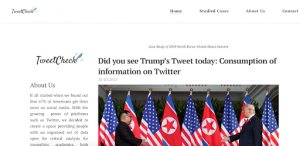
On the left side of the website, you can find the project history behind the idea of creating TweetCheck. On the right, we present all of our analysed events linked to a certain timeframe. As we want to keep adding new analysis of worldwide events, the ‘Studied Cases’ section will provide our readers with a clear overview:
 Before we launch a tool that will automatically analyze tweets through provided links, our readers can fill up a form that is available under the ‘Contact’ icon to suggest a new event that we could potentially analyse:
Before we launch a tool that will automatically analyze tweets through provided links, our readers can fill up a form that is available under the ‘Contact’ icon to suggest a new event that we could potentially analyse:
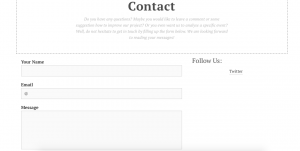
Despite the fact that the website is currently at its beginning stage with a simple outline, we aim to develop it over time with the active engagement of users.
The Case Study: 2018 United States-North Korea Summit
Donald Trump is known for referring to Kim Jong Un as a ‘little rocket man’ in his tweet on September 24th 2017, only to fall in love with the same man a year later thanks to the beautiful letters the Chairman has sent him (Independent, September 30, 2018). With such abrupt turn in their dynamic relationship, we decided to have a closer look on the impact and influence of Twitter’s coverage of global news and events, which transforms the microblogging site with the famous blue logo of a bird into one of the most powerful social media platforms (Gruber et al., 164).
How we came down to it:
We have focused on three social media accounts that can be considered as alternative news sources:
- Donald Trump’s account is a personalised Twitter profile without any official source supporting his claims. Yet it is widely used by different news media outlets to configure their news articles, by directly quoting his tweets with the consensus of the account functioning as an official platform for announcement. (Note: We selected Trump’s Twitter account instead of the official presidential Twitter account @POTUS since it retweets most of Trump’s posts from his personal account with much lower engagement rate).
- The White House account is an official communication channel which functions to provide an official report to the public and the press on the most updated events concerning the Government.
- CNN has been chosen based on its popularity. It has been used by the US public as one of the main sources for news on foreign affairs essentially through the nightly newscasts (Altheide and Grimes, 619), gradually transitioning its reach from the television to social media. CNN can be considered as a news media aiming to offer a balanced and well-informed news content to its readers. In fact, we have considered other news outlets which uses Twitter such as The Guardian or Fox News, however, their accounts either did not have enough followers or audience interactions that would provide enough data for our research.
After establishing the three accounts, we selected an event that was covered by all three users: the 2018 North Korea–United States Summit, including the time period leading to the summit as well as to its aftermath. We then analyzed tweets from 24th of May; 10th to 12th of June; and 20th of Sep 2018, using Twitter Advanced Search and searching for specific keywords and phrases in the following order:
- @realDonaldTrump – searching for phrases “Kim Jong Un” OR “North Korea”, ending up with 46 tweets mentioning one or both of these phrases
- @WhiteHouse – searching for phrases “Kim Jong Un” OR “North Korea”, ending up with 19 tweets mentioning one or both of these phrases
- @CNN – searching for phrases “Kim Jong Un” AND “Trump”, ending up with 153 tweets mentioning one or both of these phrases
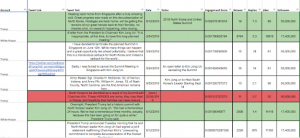
Once narrowing down our time period of the research and finding the relevant tweets through advanced search, we collected all the data (likes, retweets, comments etc.) into an Excel Sheet, and calculated the engagement rate:
- Sum up the ‘retweets’, ‘comments’, and ‘likes’, and divide it by the total number of each account’s followers. It should be noted that there are different methods of measuring the engagement rate which almost always include “impressions” (otherwise known as reach) in the equation, but since the latter can only be accessed through data acquired from twitter analytics from each account which we can not access, we chose to come up with our own equation. While we acknowledge the limitations of calculating the engagement rate, such as fake followers, we still believe it is a necessary first step to analyze the engagement until better tools come in place.

Having all the necessary data, we then visualized our findings through various graphs. We also read through the tweets and conducted textual analysis alongside each other.
Findings:
The frequency of ‘tweeting’ plays a major role in our collected data. With social media becoming more firmly embedded in everyday communication, their importance and relevance to news organisations have grown (Bowd, 132). Consequently, out of all three Twitter accounts we analysed, CNN as a news channel tweets the most often since it uses the platform in order to promote its newest articles in a real-time basis. Therefore, it is seen as a traditional mass media outlet which adopts Twitter to circulate news content repeatedly.
However, tweeting the most does not necessarily guarantee engagement from the public and this is very apparent as CNN’s account holds the most number of tweets but the least number of engagements. That is to say, despite CNN’s very official use of language and communicating events appropriately to mass media logic which aims for neutrality and independence (van Dijck & Poell 4), it holds no chance in front of Trump’s personal account which has accumulated an impressive 55.1M followers (last checked on October 14, 2018). @CNN comes in second with (40.7M followers, last checked on October 14, 2018) followed by the @WhiteHouse (17.5M, last checked on October 14, 2018).
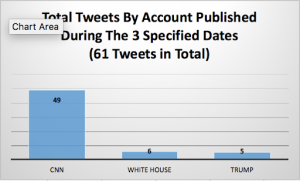
Collected data:
Firstly, we visualised tweets posted between May 24 and September 20, which reveals the general activity of the three analysed Twitter accounts throughout this period as well as the amount of tweets mentioning the topic:
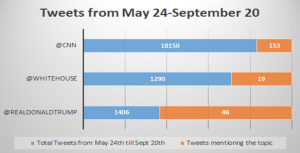
The collected data also helped us to highlight the activity of @CNN, @realDonaldTrump and @WhiteHouse from specific dates, such as June 11-12, the actual day and the immediate aftermath of the summit:
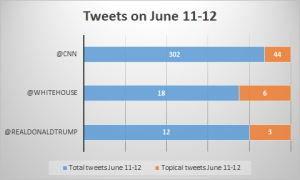
Furthermore, we calculated the engagement score for each account focusing mainly on the specified dates before the summit, on the actual day of the summit and its aftermath:
 Coming in first with the highest engagement score is a tweet that dates to June 12th and it comes from @realDonaldTrump, right after his meeting with Kim Jong Un in Singapore:
Coming in first with the highest engagement score is a tweet that dates to June 12th and it comes from @realDonaldTrump, right after his meeting with Kim Jong Un in Singapore:
“Heading back home from Singapore after a truly amazing visit. Great progress was made on the denuclearization of North Korea. Hostages are back home, will be getting the remains of our great heroes back to their families, no missiles shot, no research happening, sites closing…”.
It is somewhat ironic that the second most popular tweet dates to May 24th from the @WhiteHouse account and reads:
“A letter from the President to Chairman Kim Jong Un: “It is inappropriate, at this time, to have this long-planned meeting.”
Here, the engagement scores nicely reveal the importance of taking into account the whole image of the event, including the tweets leading to the summit. Whilst Trump boasts about his achievements in the beginning of June, the most popular tweet from the White House underlines the fragility of the whole meeting. CNN’s most popular tweet lands on the 13th place, barely scratching the average compared to its competitors:
“BREAKING: President Trump and Kim Jong Un just shook hands ahead of their historic summit. It’s the first time leaders of the US and North Korea have met”.
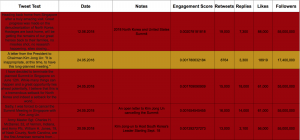
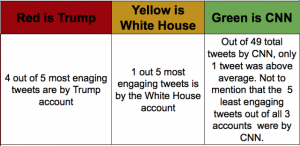
CNN’s Twitter account not only promotes its newest articles on its website but it also seeks to target audiences worldwide by constantly tweeting and republishing tweets in order to accommodate several time zones. Trump’s Twitter ventilates his ideas that sometimes provide false claims (like the one describing the economical situation of the United States) or even display spelling mistakes (including the famous word “covfefe”, with the tweet from May 31, 2017 being eventually deleted). Putting these two Twitter accounts alongside, it helps to underline the importance of being able to distinguish between fact and opinions, which the rise of new media has had a tendency to blur (van Dijck and Poell, 4).
These findings underline the necessity for a website that checks and confirms the credibility of the tweets being published especially when it concerns foreign events or news which can easily be misinterpreted by the public opinion, in this case, the American public opinion.
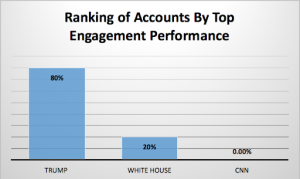
Textual analysis:
@realDonaldTrump
When it comes to addressing Kim Jong Un, Trump has come a long way. Back in September 2017, he repeatedly called Kim ‘a little rocket man’, just to talk about his relationship with the chairman as about ‘two people that like each other’ almost a year later:


Consequently, instead of insulting Kim, Trump rather thanks the Chairman in his recent tweets, which is a major difference to what was happening on the platform a year ago:
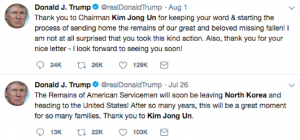
Furthermore, Trump likes to boast about his achievements during the summit alongside insulting the preceding President Barack Obama and his administration:
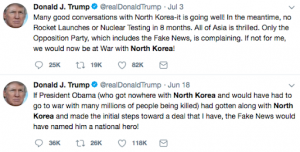

By repeatedly using positive adjectives such as “wonderful”, “exciting”, “amazing” and “great” while tweeting about the momentous summit that could have potentially turned out to be terribly wrong, he lightens up the gravity of the situation:


He also attempts to reduce the tension ahead of the summit by tweeting rather short and simple posts. Ott suggests that ‘with respect to its capacity to convey complex ideas and concepts, Twitter is the modern day equivalent of smoke signals’ (61). That is to say, because of its 280 character limit, it can never fully convey the full image, allowing Trump to present the situation in much simpler terms than it should actually be covered:
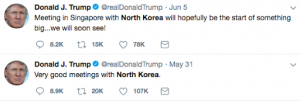
@WhiteHouse
In general, the official Twitter account of the White House has a tendency to retweet Donald Trump’s posts – which would make sense regarding the fact that the President prefers Twitter to let the world know his thoughts. However, it is striking to note that it retweets Trump’s personal account rather than his official @POTUS account which we already discussed this rather unusual choice in the previous part of our report:


The account also mentions Fox News, which demonstrates the close relationship between the President’s Office and the notoriously biased news channel that copies ‘the superficial trappings of media neutrality while explicitly articulating an ideological stance’ (van Dijck and Poell, 4):
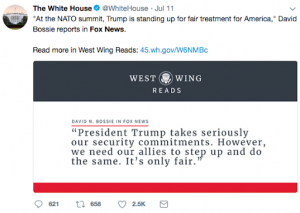
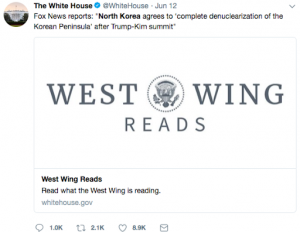
Generally, the White House’s tweets are rather short and simple, providing links to its official website:

@CNN
The television channel almost always includes links to their articles in their tweets, helping to increase the website’s traffic (Ju et. al, 5). The tweets are also usually accompanied by images or videos. The channel then uses Twitter mainly as a platform to get the articles from their website out to their readers:
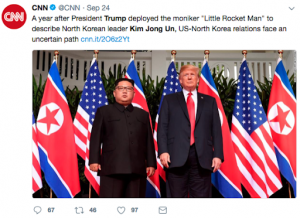
It is worth to highlight their tendency to post the same tweet twice, with the links referring back to the same articles: As Melinda F. Emerson points out, ‘the most effective use of Twitter is to drive traffic’ (New York Times, 2014). In fact, in the same article, Guy Kawasaki explains that ‘CNN repeats stories all day long — because they know people watch them at different times of the day. People in different time zones and people in the same time zone visit Twitter at different times, so you need to keep posting your content to accommodate all these people’(New York Times, 2014):
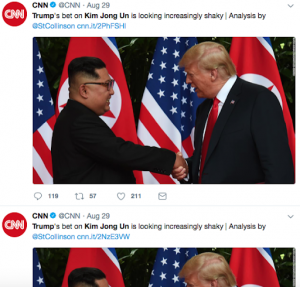

Having these findings in mind, one can clearly see the tweeting style of the three analysed accounts. Both @CNN and @WhiteHouse mainly provide links to their websites, usually avoiding any sensational or sentimental use of language, and remaining neutral (if one disregards @WhiteHouse retweeting Fox News). Trump’s Twitter account, on the other hand, reveals his opinions rather than facts and news, which is important to highlight. He has a tendency to boast about his achievements and criticise others, where he also easily changes his perception of people, like he has done with the Chairman, Kim Jong Un, formally called on Trump’s Twitter as ‘the little rocket man’.
What Next: The Future of TweetCheck
Looking back at our research and findings, we are confident in our website which will gradually develop into a more sophisticated version over time. With more and more people using social media as their main source for their news whether it is on the national or international level (Shearer and Gottfried, 2017), it is necessary to bare in mind that not all news on social media can be regarded as trustworthy. For that reason, our website TweetCheck aims to build up a place which would critically analyse worldwide events covered by multiple users on Twitter, helping the audience to distinguish fiction from truth.
Bibliography:
- Bowd, Kathryn. ‘Social Media and News Media: Building New Publics or Fragmenting Audiences?’. In Making Public, Making Places. Edited by Mary Griffiths and Kim Barbour. University of Adelaide Press (2016).
- Emerson, Melinda, F.. ‘How Many Times Can You Tweet the Same Tweet?’. The New York Times, September 14, 2012. https://boss.blogs.nytimes.com/2012/09/14/how-many-times-can-you-tweet-the-same-tweet/. Accessed October 7, 2018.
- Gray et al., ‘Ways of Seeing Data: Toward a Critical Literacy for Data Visualizations as Research Objects and Research Devices’. In Innovative Methods in Media and Communication Research (2016): 227-251.
- Gruber, Daniel A. et al.. “The Real-time Power of Twitter: Crisis Management and Leadership in an Age of Social Media”. Business Horizons 58 (2015): 163-172.
- Internet Live Stats. ‘Twitter Statistics’, http://www.internetlivestats.com/twitter-statistics/ . Accessed October 10, 2018.
- Ju, Alice, Sun Ho Jeong & Hsiang Iris Chyi. ‘Will Social Media Save Newspapers?’. Journalism Practice 8.1 (2014): 1-17.
- Lewandowsky et al. “Beyond Misinformation: Understanding and Coping with the Post-Truth Era”. Journal of Applied Research in Memory and Cognition 6 (2017): 353-369.
- Ott, Brian L.. “The Age of Twitter: Donald J. Trump and the Politics of Debasement”. Critical Studies in Media Communication 34.1 (December 2016): 59-68.
- Picard, Robert G. “Twilight or New Dawn of Journalism?”. Journalism Practice 8.5 (2014): 488-498.
- Shearer, Elisa , and Jeffrey Gottfried. ‘News Use Across Social Media Platforms 2017’, Pew Research Center. September 7, 2017. http://www.journalism.org/2017/09/07/news-use-across-social-media-platforms-2017. Accessed October 4, 2018.
- van Dijck, J., & Poell, T. “Understanding Social Media Logic”. Media and Communication 1.1 (2013): 2-14.
- Vernon, Peter. ‘The daily White House Press Briefing Is Dead. Does It Matter?’, CJR. September 21, 2018. https://www.cjr.org/the_media_today/briefing-trump-sanders.php . Accessed October 5, 2018.
- Zubiaga, Arkaitz et al. “Real-Time Classification of Twitter Trends”. Journal of the Association for Information Science and Technology 66.3 (2014): 462–73.